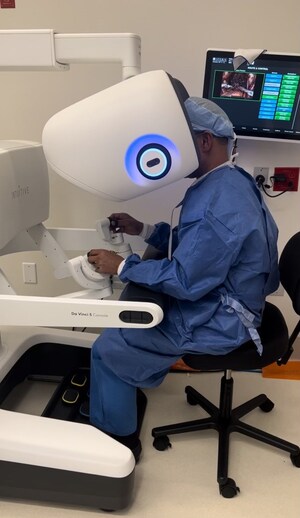Treatment Is a Safe and Effective Alternative to Surgery and Laser Therapies
HACKENSACK, N.J., Aug. 29, 2022 /PRNewswire/ -- Urologists at Hackensack University Medical Center have become the first in northern New Jersey to offer an innovative treatment for benign prostatic hyperplasia (BPH) that uses a high-intensity waterjet to destroy (ablate) excess prostate tissue that causes uncomfortable urinary symptoms for many older men. Aquablation®therapy is an option for men whose prostate enlargement cannot be effectively treated using prostate-shrinking medications. Aquablation therapy is performed using the AquaBeam Robotic System, guided by real-time imaging to deliver treatment with extraordinary precision.
BPH is the most common reason men see a urologist. About half of all men aged 51-60 develop BPH, and the incidence rises with each decade of life. It causes symptoms that impair quality of life, such as trouble urinating, feeling like they cannot fully empty the bladder, and needing to urinate frequently — including multiple overnight trips to the bathroom that can impact sleep.
Some 30-50 million men in the United States have BPH, 10-15 million of whom are actively managing their condition with medications (such as Flomax® or Proscar®) or other treatment. In more than one million men each year, BPH medications are not effective enough and patients need surgery. Most urologists counsel their patients to try medication for at least 4 weeks before resorting to surgery.
The most common surgical approaches are transurethral resection of the prostate (TURP), in which the prostate tissue is removed through the urethra, and GreenLight laser surgery, which vaporizes prostate tissue. Both treatments may cause sexual side effects such as retrograde ejaculation, in which semen backs up into the bladder when a man ejaculates; in the case of laser treatment, as many as 90% of patients may experience this side effect. Flomax is also associated with this side effect, while Proscar can reduce sex drive and cause erectile dysfunction and hot flashes.
Aquablation therapy is indicated for any man whose prostate is causing an obstruction, and who cannot achieve relief with medication or does not want to take these drugs. "Aquablation therapy is as effective as these other minimally invasive treatments but with fewer side effects, including only a 10-15% risk of retrograde ejaculation," explained Ravi Munver, M.D., vice chair of Urology and division director of Minimally Invasive and Robotic Urologic Surgery at Hackensack University Medical Center. "Aquablation is performed using a robotic system with ultrasound guidance. As a result, the procedure can be completed rapidly and with a higher level of precision that is reproducible from surgeon to surgeon. The advantage of real-time ultrasound imaging is that a surgeon can see where the prostate tissue ends, which allows removal of more of the excess tissue. Aquablation therapy is the only heat-free and image-guided waterjet ablation approach that is available to treat BPH."
Here's how it works: The patient is asleep under anesthesia. An ultrasound probe is inserted into the patient's rectum to produce clear images of the prostate. The addition of ultrasound imaging enables the surgeon to map the parts of the prostate to remove and the parts to avoid. The Aquablation scope is inserted into the urethra. When ready to begin, the surgeon presses on a foot pedal and the Aquablation system advances through the prostate, delivering a heat-free waterjet so intense that it can remove the prostate tissue that has been mapped out. See a video of Aquablation in action.
"Depending on the size of the prostate, the resection time may take as little as 5 minutes," said Michael D. Esposito, M.D., Hackensack University Medical Center. Dr. Esposito explained that the patient stays in the hospital overnight with a urinary catheter and typically goes home as soon as the next day. Patients report feeling a reduction in BPH symptoms right away and are able to go off their BPH medications. "Aquablation achieves years of prostate relief, and we're thrilled to offer this new option to our patients."
High-tech treatments such as Aquablation therapy are best suited to centers with expertise and high volumes in the field of robotic surgery. "For years, Hackensack University Medical Center has been a national leader in the use of robotic surgery, especially for urologic procedures, and we have trained many other surgeons in its use," noted Michael Stifelman, M.D., chair of Urology. "We are proud to be the first in northern New Jersey to offer this innovative treatment to restore comfort and quality of life to men with BPH."
Hackensack University Medical Center, a 781-bed nonprofit teaching and research hospital, was Bergen County's first hospital founded in 1888. It was also the first hospital in New Jersey and second in the nation to become a Magnet®-recognized hospital for nursing excellence, receiving its sixth consecutive designation from the American Nurses Credentialing Center. The academic flagship of the Hackensack Meridian Health network, Hackensack University Medical Center is Nationally-Ranked by U.S. News & World Report 2022-2023 in four specialties, more than any other hospital in New Jersey. The hospital is home to the state's only nationally-ranked Urology and Neurology & Neurosurgery programs, as well as the best Cardiology & Heart Surgery program. It also offers patients nationally-ranked Orthopedic care and one of the state's premier Cancer Centers (John Theurer Cancer Center at Hackensack University Medical Center). Hackensack University Medical Center also ranked as High-Performing in conditions such as Acute Kidney Failure, Heart Attack (AMI), Heart Failure, Pneumonia, chronic obstructive pulmonary disease (COPD), Diabetes and Stroke. As well as High Performing in procedures like Aortic Valve Surgery, Heart Bypass Surgery (CABG), Colon Cancer Surgery, Lung Cancer Surgery, Prostate Cancer Surgery, Hip Replacement and Knee Replacement. This award-winning care is provided on a campus that is home to facilities such as the Heart & Vascular Hospital; and the Sarkis and Siran Gabrellian Women's and Children's Pavilion, which houses the Donna A. Sanzari Women's Hospital and the Joseph M. Sanzari Children's Hospital, ranked #1 in the state and top 20 in the Mid-Atlantic Region in the U.S. News & World Report's 2022-23 Best Children's Hospital Report. Additionally, the children's nephrology program ranks in the top 50 in the United States. Hackensack University Medical Center is also home to the Deirdre Imus Environmental Health Center and is listed on the Green Guide's list of Top 10 Green Hospitals in the U.S. Our comprehensive clinical research portfolio includes studies focused on precision medicine, translational medicine, immunotherapy, cell therapy, and vaccine development. The hospital has embarked on the largest healthcare expansion project ever approved by the state: Construction of the Helena Theurer Pavilion, a 530,000-sq.-ft., nine-story building, which began in 2019. A $714.2 million endeavor, the pavilion is one the largest healthcare capital projects in New Jersey and will house 24 state-of-the-art operating rooms with intraoperative MRI capability, 50 ICU beds, and 175 medical/surgical beds including a 50 room Musculoskeletal Institute.
SOURCE Hackensack University Medical Center

WANT YOUR COMPANY'S NEWS FEATURED ON PRNEWSWIRE.COM?
Newsrooms &
Influencers
Digital Media
Outlets
Journalists
Opted In






Share this article